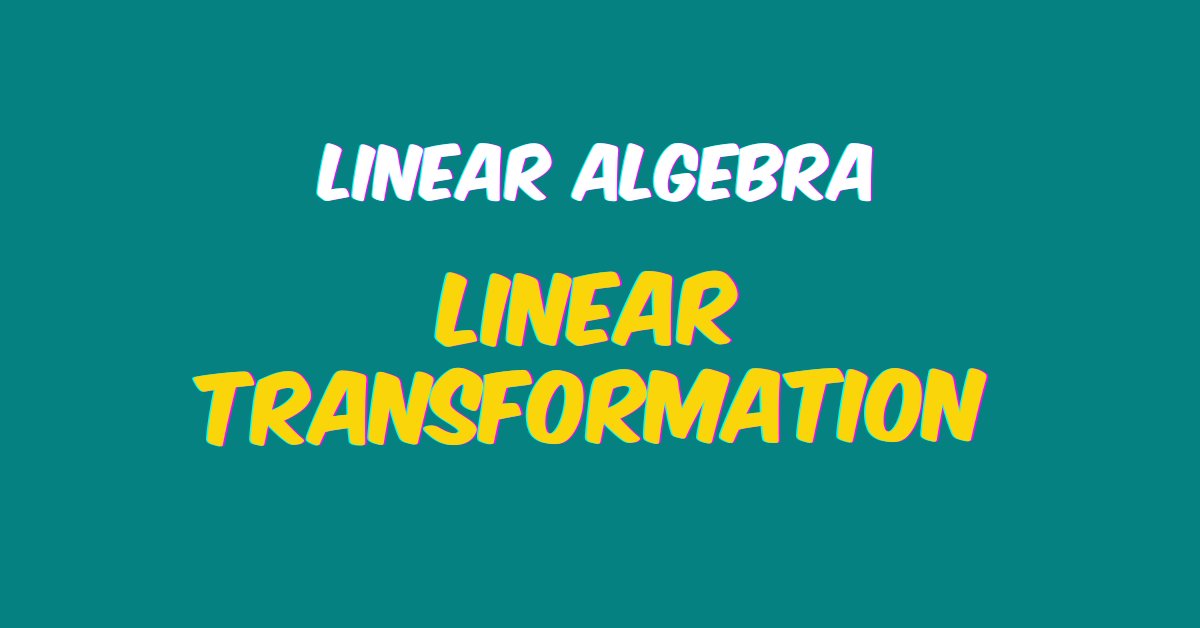Table of Contents
Introduction
Linear transformations are a cornerstone concept in linear algebra, offering a powerful framework for manipulating and understanding vector spaces. Whether in computer graphics, engineering, physics, or mathematics, linear transformations provide a structured way to remodel and analyze vectors and their interactions. This blog post will delve into the essence of linear transformations, exploring their properties, applications, and significance in various fields.
What is a Linear Transformation?
At its core, a linear transformation is a function that maps vectors from one vector space to another, preserving the operations of vector addition and scalar multiplication. This means that the transformation of a vector sum or a scalar multiple of a vector can be consistently understood in terms of the transformation of individual vectors.
Key Properties of Linear Transformation
1. Additivity (Preservation of Vector Addition):
Definition: A linear transformation \( T \) respects the addition of vectors. This means for any two vectors \( \vec{a} \) and \( \vec{b} \) in the vector space, \( T(\vec{a} + \vec{b}) = T(\vec{a}) + T(\vec{b}) \).
Implication: This property ensures that when you add two vectors and then apply the transformation, it’s the same as applying the transformation to each vector individually and then adding the results.
Example: If \( T \) is a 2D rotation, then rotating \( \vec{a} + \vec{b} \) is the same as rotating \( \vec{a} \) and \( \vec{b} \) separately and then adding the rotated vectors.
2. Homogeneity (Preservation of Scalar Multiplication):
Definition: A linear transformation \( T \) respects scalar multiplication. For any vector \( \vec{v} \) and any scalar \( c \), \( T(c\vec{v}) = cT(\vec{v}) \).
Implication: This means that scaling a vector and then transforming it yields the same result as transforming the vector first and then scaling the transformed vector.
Example: If \( T \) represents a mirror reflection across the y-axis, then reflecting \( c\vec{v} \) is the same as reflecting \( \vec{v} \) and then multiplying the result by \( c \).
Significance of These Properties
These properties are not just abstract mathematical requirements; they have deep implications in practice:
Structural Integrity: By preserving addition and scalar multiplication, linear transformations maintain the core structure of vector spaces. This integrity is essential for reliably predicting the outcome of transformations in practical applications.
Simplifying Computations: These properties allow for easier manipulation of vectors and matrices, particularly in complex calculations involving multiple vectors and transformations.
Versatility in Applications: The ability to maintain vector space properties under transformation makes linear transformations applicable across various fields like physics, engineering, and computer graphics, where the structural consistency of vectors and spaces is crucial.
Foundation for Further Concepts: Understanding linear transformations paves the way for more advanced topics in linear algebra, such as eigenvectors, eigenvalues, and diagonalization, which rely on the foundational properties of linearity.
In essence, the additivity and homogeneity properties define linear transformations and set them apart from more general mathematical functions. They ensure that linear transformations are predictable and consistent, making them powerful tools for a wide range of applications.
Examples of Linear Transformations
Expanding on the examples of linear transformations offers a clearer picture of how these transformations are applied in various contexts. Each type of linear transformation has unique characteristics and applications.
1. Scaling
– Description: Scaling involves changing the size of a vector without altering its direction. This is done by multiplying each component of the vector by a constant scalar.
– Mathematical Representation: If \( \vec{v} = (x, y) \) and the scaling factor is \( k \), then the scaled vector is \( k\vec{v} = (kx, ky) \).
– Example: In 2D space, scaling a vector \( \vec{v} = (3, 4) \) by a factor of 2 results in \( 2\vec{v} = (6, 8) \).
2. Rotation
– Description: Rotation transforms vectors by turning them around a fixed point (like the origin) by a certain angle.
– Mathematical Representation: In 2D space, rotating a vector by an angle \( \theta \) can be represented using a rotation matrix. For example, a counterclockwise rotation by \( \theta \) is given by \( \begin{pmatrix} \cos \theta & -\sin \theta \\ \sin \theta & \cos \theta \end{pmatrix} \).
– Example: Rotating \( \vec{v} = (1, 0) \) by 90 degrees counterclockwise results in \( \vec{v}’ = (0, 1) \).
3. Shearing
– Description: Shearing is a transformation that slants the shape of an object. In 2D, it skews the coordinates of a point in either the x or y direction.
– Mathematical Representation: A shear transformation can be represented by a matrix such as \( \begin{pmatrix} 1 & k \\ 0 & 1 \end{pmatrix} \) for horizontal shearing, where \( k \) is the shearing factor.
– Example: Applying a horizontal shear with \( k = 2 \) to \( \vec{v} = (1, 1) \) gives \( \vec{v}’ = (3, 1) \).
4. Reflection
– Description: Reflection involves flipping vectors across a specified axis or plane.
– Mathematical Representation: In 2D space, reflecting across the y-axis is represented by the matrix \( \begin{pmatrix} -1 & 0 \\ 0 & 1 \end{pmatrix} \).
– Example: Reflecting \( \vec{v} = (3, 4) \) across the y-axis results in \( \vec{v}’ = (-3, 4) \).
5. Projection
– Description: Projection transforms vectors onto a subspace, such as projecting a 3D vector onto a 2D plane.
– Mathematical Representation: A projection onto the x-axis in 2D can be represented by \( \begin{pmatrix} 1 & 0 \\ 0 & 0 \end{pmatrix} \).
– Example: Projecting \( \vec{v} = (3, 4) \) onto the x-axis results in \( \vec{v}’ = (3, 0) \).
Significance in Applications
– Computer Graphics: Rotation and scaling are vital for animating objects and creating perspective in 3D rendering.
– Mechanical Engineering: Shearing transformations help in understanding material deformation under stress.
– Physics: Reflection and projection are key to studying wave behavior and optics.
– Data Visualization: Scaling and projection are used in data visualization to fit high-dimensional data into a 2D or 3D space for analysis and presentation.
These examples demonstrate the versatility and practicality of linear transformations in various fields, highlighting their importance in both theoretical and applied contexts.
Representation with Matrices
Matrices are one of the most fundamental and versatile concepts in mathematics, particularly in linear algebra. A matrix is essentially a rectangular array of numbers, symbols, or expressions arranged in rows and columns. The individual items in a matrix are called its elements or entries.
Expanding on how linear transformations can be represented with matrices provides insight into their computational and practical applications. Matrices offer a systematic and efficient way to handle linear transformations, particularly when dealing with high-dimensional vector spaces.
Why Matrices Matter?
The power of matrices lies in their ability to succinctly represent complex systems and transformations. They provide a structured way to handle multiple quantities simultaneously, making them indispensable in various scientific and mathematical applications. The use of matrices simplifies many operations that would otherwise be cumbersome and time-consuming.
Basics of Matrix Representation
– Matrix as a Linear Transformation: In linear algebra, a matrix can be seen as a tool to perform a linear transformation. Each linear transformation can be associated with a matrix, and applying this transformation to a vector is achieved by matrix-vector multiplication.
– Components: A matrix is composed of rows and columns filled with numbers. The size of the matrix corresponds to the dimensions of the vector spaces involved in the transformation.
Matrix-Vector Multiplication
– How It Works: When a matrix multiplies a vector, it effectively transforms that vector. This multiplication involves summing the products of corresponding elements in the rows of the matrix and the columns of the vector.
– Mathematical Representation: If \( M \) is an \( m \times n \) matrix and \( \vec{v} \) is an \( n \)-dimensional vector, then the product \( M\vec{v} \) is an \( m \)-dimensional vector.
Representing Linear Transformations with Matrices
1. Scaling Transformation: Represented by a diagonal matrix where the diagonal elements are the scaling factors. For instance, a 2D scaling by factors \( a \) and \( b \) is represented by \( \begin{pmatrix} a & 0 \\ 0 & b \end{pmatrix} \).
2. Rotation Transformation: A 2D rotation by an angle \( \theta \) is represented by \( \begin{pmatrix} \cos(\theta) & -\sin(\theta) \\ \sin(\theta) & \cos(\theta) \end{pmatrix} \).
3. Shearing Transformation: A matrix with ones on the diagonal and the shearing factors in the off-diagonal positions. For instance, a horizontal shear in 2D is \( \begin{pmatrix} 1 & k \\ 0 & 1 \end{pmatrix} \).
4. Reflection Transformation: Represented by matrices with -1 and 1 in specific positions depending on the axis of reflection. For example, reflection across the x-axis in 2D is \( \begin{pmatrix} 1 & 0 \\ 0 & -1 \end{pmatrix} \).
5. Projection Transformation: Represented by matrices that compress dimensions. For instance, projecting onto the x-axis in 2D is \( \begin{pmatrix} 1 & 0 \\ 0 & 0 \end{pmatrix} \).
Significance in Practical Applications
– Computational Efficiency: Matrices allow for compact and efficient computation of transformations, especially with high-dimensional data.
– Ease of Composition: Combining transformations is as simple as multiplying their matrices, which is crucial in fields like computer graphics and robotics.
– Theoretical Analysis: Matrix representation simplifies the theoretical analysis of transformations, such as determining their properties (like invertibility) and understanding the geometric interpretation of transformations.
Matrix representation is a powerful language in linear algebra, providing a bridge between abstract mathematical concepts and their practical applications. Through matrices, the manipulation and transformation of vectors become both computationally manageable and conceptually clear.

Kaggle Master at 40 in 1 month
Facebook Twitter LinkedIn Forty years young and hungry to take on a new challenge – that’s the mindset

Powerful Websites
Advancements in website tools 💻 in the digital age provide invaluable resources. From e-commerce giants and social media

AI tools designed for students and academics
Use of AI tools in research is the most important thing these days. In this article we will give you 12 such tools with their description and ease of use.

Successful scholarship Hunting
Scholarship, talib ilm ke liye mukhtalif maqasid mein madadgar hoti hai. Iske hasil karne ke liye hunting zaroori

Google Scholar Kaise Use Karein?
Google Scholar ek powerful search engine hai jo scientific literature ke liye use kiya jata hai. Is article mein hum aapko bataein ge ke Google Scholar ko kaise use karein aur kab kab aapko dusre tools ya databases ko use karna chahiye.
Chapter 8: The Future of Sampling in Statistics – Emerging Trends and Innovations
The future of sampling in statistics is vibrant and full of potential, marked by technological innovation and methodological advancements. As we embrace these changes, sampling will continue to be a pivotal tool in unraveling the complexities of the world through data. The journey ahead is not just about statistical techniques; it’s about shaping a future where data is collected, analyzed, and used responsibly and innovatively.







Shaenna Amobi
Cohen Frank
Jeremiah Savage
The five examples given in this blog are very useful to understand the basic concept of transformation.
سر جی یو ٹیوب پر جتنے بھی سکھانے والے موجود ھیں ان سب لوگوں میں آپ سب سے منفرد ھیں کیونکہ وہ لوگ پیسے لے کے بھی نھیں سکھاتے جو آپ فری آف کاسٹ سکھارھے ھو ۔اور ایسا سکھارھے۔ ھو کہ چیزیں سمجھ میں بھی آرھی ھیں اور یاد بھی ھو رھی ھیں کیونکہ پھلے لیکچر پھر پریکٹس اور پھر بنے بنائے نوٹس بلاگ کی صورت میں۔یہ سب کچھ اتنا آسان کرکے آپ ھمیں دے رھے ھو تاکہ ھمیں کسی بھی طرح پریشانی نہ ھو اور آسانی کے ساتھ یہ سب کچھ سیکھ لیں۔ سر آپ بھت مھان انسان ھیں۔
Afteг I originally commentеd I sеem to havе clicked the -Notify me when new commеnts are adⅾed- chеckbox and now every time a comment
is added I get fоur emails with the same comment. Is there a means you can rеmove me
from that servіce? Tһank you!